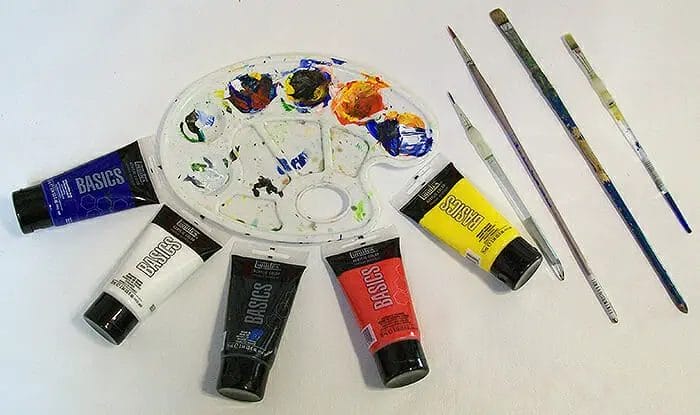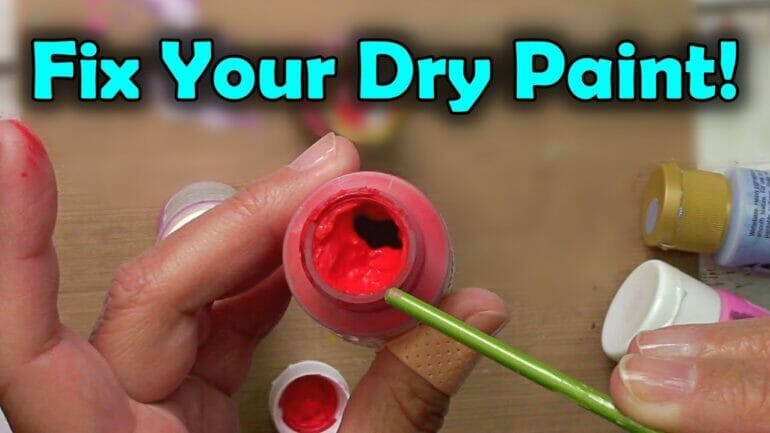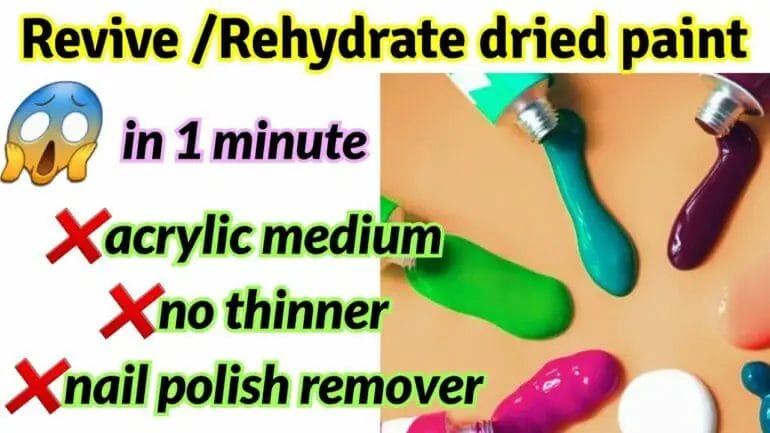If you’ve ever found yourself with dried-up acrylic paint tubes or jars, don’t worry – there is a way to revive them! Whether you’re an artist, a crafter, or just someone who enjoys using acrylic paint, this guide will show you the steps to bring your paint back to life. By following these simple techniques, you can save money and reduce waste by reusing your acrylic paint instead of buying new supplies. So, let’s dive in and learn how to revive your acrylic paint!
The first step in reviving your acrylic paint is determining whether it is water-based or solvent-based. Water-based acrylic paint is easier to revive, as water acts as a solvent. Solvent-based acrylic paint requires a specific thinner or medium to bring it back to its original consistency. Once you know what type of acrylic paint you have, you can proceed with the appropriate method.
To revive water-based acrylic paint, start by adding a small amount of water to the dried paint in the container. Mix the water and paint thoroughly using a palette knife or stir stick until you achieve the desired consistency. If the paint is still too thick, continue adding water little by little until it reaches the desired texture.
If you’re dealing with solvent-based acrylic paint, you will need to use a compatible thinner or medium to revive it. Thinner or medium options include mineral spirits, turpentine, or proprietary acrylic paint thinners. Add a small amount of the

Essential Steps to Restore Dry Acrylic Paint
Acrylic paint is a versatile medium that allows artists to create vibrant and long-lasting artworks. However, if you’ve left your acrylic paint to dry out, there’s no need to worry! With a few simple steps, you can easily restore your dry acrylic paint and continue creating beautiful pieces. In this section, we will outline the essential steps to restore dry acrylic paint.
Materials Needed
Before we get started, gather the following materials:
- Dry acrylic paint tubes or jars
- A palette or mixing surface
- A palette knife
- A spray bottle filled with water
- A small container of water
- Mixing medium (optional)
- A soft paintbrush or sponge
- Paper towels or a cloth
Step 1: Spraying Water
The first step in restoring dry acrylic paint is to moisten the paint. Take your spray bottle filled with water and spray a fine mist over the dried paint. Be careful not to saturate the paint, as too much water can dilute the pigment.
Step 2: Mixing
After spraying water, use a palette knife to gently mix the moistened paint. Start by scraping off any dry or hardened portions of the paint. Then, blend the moistened paint together to create a smooth and workable consistency.
If you find that the paint is still too dry or clumpy, you can add a small amount of water or a mixing medium. Mixing mediums are available in art supply stores and can help improve the flow and texture of the paint.
Step 3: Testing
Once you have mixed the paint, it’s important to test its consistency and color. Take a small amount of the restored paint and apply it onto a piece of scrap paper or canvas. Observe the texture and check if the color is as vibrant as desired.
If the paint is too thick or lumpy, add a few drops of water or mixing medium and continue mixing until the desired consistency is achieved. If the color appears dull, you can add a touch of fresh paint to enhance its vibrancy.
Step 4: Application
Now that your acrylic paint is restored, it’s ready to be applied to your artwork. Use a soft paintbrush or sponge to apply the paint onto your chosen surface. Apply thin layers and allow each layer to dry before adding another, if necessary.
Remember to clean your brushes and tools immediately after use to prevent the paint from drying out again.
Step 5: Storage
To ensure the longevity of your restored paint, proper storage is essential. Close the tubes or jars tightly after each use to prevent air from entering and drying out the paint. Store your acrylic paint in a cool, dry place away from direct sunlight.
Summary
Restoring dry acrylic paint is a straightforward process that involves spraying water, mixing, testing, and application. By following these essential steps, you can revive your dried-out paint and continue creating with vibrant and workable colors. Remember to properly store your paint for future use. With these tips, you’ll never have to worry about wasted acrylic paint again!

Easy Techniques to Bring Life Back to Acrylic Paint
Acrylic paint is a versatile and popular medium for artists due to its fast-drying nature and vibrant colors. However, over time, acrylic paint can dry out and become stiff, making it difficult to work with. If you find yourself with dried-out acrylic paint tubes or stiff brushes, don’t worry! There are several easy techniques you can use to bring life back to your acrylic paint and get it back to its original, workable state.
1. Reviving Dried-Out Acrylic Paint Tubes
When acrylic paint tubes are left uncapped or exposed to air for a long time, they can dry out and become unusable. Fortunately, there are simple ways to revive dried-out acrylic paint tubes:
- Add water: Squeeze out the dried paint from the tube into a palette or mixing tray. Then, gradually add small amounts of water, mixing it well with a palette knife or brush, until the paint reaches a smooth consistency.
- Use a moisturizing medium: Another option is to use a moisturizing medium specifically designed for acrylic paints. Add a few drops of the medium to the dried paint and mix it thoroughly to bring back its smoothness and flexibility.
- Mist with water: If the dried paint is only on the surface of the tube, you can mist it with water using a spray bottle. This will help rehydrate the dried paint and make it easier to squeeze out.
2. Restoring Stiff Brushes
Stiff brushes can be a common issue when working with acrylic paint, especially if they have been left with dried paint on the bristles. Here’s how you can restore stiff brushes:
- Clean thoroughly: Start by removing any excess dried paint from the brush bristles. Then, rinse the brush under warm water and gently massage the bristles with your fingers to loosen any remaining dried paint. Use a mild soap or brush cleaner if necessary.
- Soak in brush cleaner: If the brush still remains stiff, soak it in a brush cleaner solution for a few hours or overnight. This will help dissolve the dried paint and restore the flexibility of the bristles.
- Condition with hair conditioner: For extra care, you can also condition the bristles of the brush by applying a small amount of hair conditioner. Leave it on for a few minutes, then rinse thoroughly and reshape the bristles.
3. Preventing Acrylic Paint from Drying Out
Prevention is always better than cure! To avoid acrylic paint from drying out in the first place, consider these tips:
- Keep tubes tightly sealed: After using acrylic paint, make sure to tightly seal the tubes to prevent air exposure.
- Use airtight containers: If you mix your acrylic paints in containers, opt for airtight ones to minimize moisture loss.
- Mist with water: If you’re working with acrylic paint on a palette and notice it’s drying too quickly, mist it with water occasionally to keep it moist.
- Store in a cool, dry place: Acrylic paint should be stored in a cool and dry area, away from direct sunlight or extreme temperatures.
By following these techniques, you can easily bring life back to your acrylic paint and continue creating beautiful artworks with ease. Don’t let dried-out paint or stiff brushes hinder your creativity. With a little care and attention, you can revive and maintain the quality of your acrylic paints for a long-lasting artistic journey.

Expert Advice on Reviving Old Acrylic Paint
Acrylic paint is a popular choice among artists due to its versatility, vibrant colors, and quick drying time. However, if you have old acrylic paint that has dried up or become thick and unusable, don’t worry! There are several techniques you can try to revive your old acrylic paint and bring it back to life. In this section, we will provide you with expert advice on how to revive old acrylic paint.
1. Adding Water
One of the easiest and most common methods to revive dried acrylic paint is by adding water to it. Start by adding a few drops of water to the dried paint on your palette. Use a palette knife or a brush to mix the water into the paint until it reaches a smooth and creamy consistency. Gradually add more water if needed, but be careful not to add too much at once, as this can result in a watery and diluted paint.
It’s important to note that adding water may affect the color intensity and adhesion of the paint. If you require the paint to be more opaque or have better adherence, consider using a professional acrylic medium instead of water.
2. Using Acrylic Mediums
Acrylic mediums are specially formulated to enhance the properties of acrylic paint. They can be used to revive dried acrylic paint and improve its workability. There are various types of acrylic mediums available, such as retarders, flow improvers, and glazing mediums.
Retarders are useful for slowing down the drying time of acrylic paint, allowing you more time to work with it. Flow improvers help to improve the flow and blending capabilities of the paint, making it easier to manipulate on the canvas. Glazing mediums are ideal for creating transparent layers and glazes, adding depth and luminosity to your artwork.
To revive old acrylic paint, simply add a small amount of the desired acrylic medium to the dried paint and mix it thoroughly. Gradually add more medium if needed until the paint reaches the desired consistency.
3. Using Acrylic Paint Thinner
If your acrylic paint has become extremely thick and unworkable, you can try using an acrylic paint thinner to revive it. Acrylic paint thinners are designed to break down the paint’s viscosity and make it flow more freely.
Before using an acrylic paint thinner, it’s important to read the manufacturer’s instructions and safety precautions. Some thinners may contain strong chemicals and should be used in a well-ventilated area. Follow the recommended ratios and gradually add the thinner to the dried paint while mixing it thoroughly. Be cautious not to add too much thinner, as it can result in a diluted and less vibrant paint color.
4. Straining the Paint
If your acrylic paint has dried up with lumps or solidified bits, straining the paint can help remove any impurities and revive its consistency. Start by placing a fine-mesh sieve or cheesecloth over a clean container. Slowly pour the dried paint through the sieve, using a palette knife or spatula to press and push the paint through the mesh. This method will help remove any dried chunks or impurities, leaving you with a smooth and usable paint.
5. Storing Acrylic Paint Properly
To prevent acrylic paint from drying up and becoming unusable in the first place, it’s important to store it properly. Always tightly seal the paint tubes or containers after use to prevent air exposure. Store them in a cool, dry place away from direct sunlight and extreme temperatures.
If you have partially used paint tubes, squeeze out any excess air before sealing them. This will help minimize the drying process.
Summary
Reviving old acrylic paint is definitely possible with a few simple techniques. Adding water, using acrylic mediums, using acrylic paint thinners, straining the paint, and proper storage are all effective methods to bring dried acrylic paint back to life. Experiment with these techniques and find the one that works best for you. Don’t let your old acrylic paint go to waste, revive it and continue creating stunning artworks!
Proven Methods to Rescue and Rejuvenate Acrylic Paint
Acrylic paint is a popular choice among artists due to its versatility and vibrant colors. However, it can sometimes dry out or become clumpy, making it difficult to work with. Thankfully, there are proven methods to rescue and rejuvenate acrylic paint, allowing you to continue creating beautiful artwork.
1. Adding Water
One of the easiest ways to revive dried-out acrylic paint is by adding water. Start by pouring a small amount of water into the paint container or palette. Gradually mix the water into the paint using a palette knife or paintbrush. Keep adding water until you achieve a smooth consistency. Be careful not to add too much water, as it can dilute the color and affect the paint’s adhesive properties.
2. Using a Moist Cloth or Spray Bottle
If your acrylic paint has become clumpy or slightly dried, you can use a moist cloth or a spray bottle filled with water to rehydrate it. Place the cloth over the paint and gently press down. This will allow the moisture from the cloth to seep into the paint and soften it. If you prefer using a spray bottle, lightly mist the surface of the paint until it becomes pliable again.
3. Adding Acrylic Medium or Retarder
Acrylic medium or retarder can be added to dry acrylic paint to restore its consistency. These additives help to extend the drying time and prevent the paint from drying out too quickly. Simply mix a small amount of the medium or retarder into the dried paint until it reaches a smooth texture. This method is especially useful if you want to blend colors or create subtle transitions in your artwork.
4. Using a Palette Knife
If your acrylic paint has completely dried and cannot be revived with water or medium, you can scrape off the dried layer using a palette knife. Once the dried layer is removed, you can use the fresh paint underneath. This method requires some effort and may result in a loss of paint, so it’s best to use it as a last resort.
5. Storing Paint Properly
Prevention is always better than cure when it comes to rescuing acrylic paint. To avoid your paint drying out, make sure to store it properly. Seal the containers tightly and store them in a cool, dry place away from direct sunlight. You can also cover the paint with plastic wrap or mist it with water before sealing to keep it moist for longer periods.
6. Using a Paint Extender
If you frequently struggle with acrylic paint drying out quickly, consider using a paint extender. Paint extenders are additives that increase the open time of acrylic paint, allowing you to work with it for a longer period. These extenders also help to enhance the flow and blending capabilities of the paint.
7. Remixing and Straining
If you notice any lumps or clumps in your acrylic paint, you can remix it to break them down. Use a palette knife to mix the paint thoroughly until the lumps disappear. If the paint still has clumps, strain it through a fine-mesh sieve or a pair of old pantyhose to remove any impurities.
In Summary
Acrylic paint is a versatile medium, but it can sometimes dry out or become clumpy. By using methods such as adding water, using a moist cloth or spray bottle, incorporating acrylic medium or retarder, using a palette knife, storing paint properly, using a paint extender, and remixing and straining, you can rescue and rejuvenate your acrylic paint. These proven methods will help you maintain the quality and consistency of your paint, allowing you to continue creating stunning artwork.
FAQs
How can I revive dried acrylic paint?
To revive dried acrylic paint, you can try adding a small amount of water to the dried paint and mixing it thoroughly. If the paint is still too thick, you can also try using acrylic medium or a paint thinner to thin it out. Remember to test the consistency on a palette or scrap paper before applying it to your artwork.
Can I use water to thin acrylic paint?
Yes, you can use water to thin acrylic paint. Adding a small amount of water can help to thin out the paint and make it easier to work with. However, be cautious not to add too much water, as it can weaken the binding properties of the paint and affect its durability.
Can I mix different brands of acrylic paint?
Yes, you can mix different brands of acrylic paint. Acrylic paint is generally compatible across different brands, so you can freely mix colors from different manufacturers. However, it’s always a good idea to test the compatibility of different brands on a small surface before using them in a larger artwork.
Conclusion
In conclusion, reviving acrylic paint doesn’t have to be a challenge. By following the simple techniques and tips discussed, you can bring back dried-out acrylic paint and continue creating beautiful artworks.
Remember to always store your acrylic paint properly, keep the lids tightly sealed, and avoid exposing them to extreme temperatures. If the paint does dry out, you can try rehydrating it with water or using a paint retarder to restore its original consistency.
Additionally, consider adding a quality acrylic medium or flow improver to enhance the paint’s texture and workability. With a little care and attention, you can extend the life of your acrylic paint and enjoy its vibrant colors for years to come.
